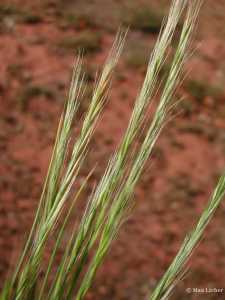Annuals, Terrestrial, not aquatic, Stems nodes swollen or brittle, Stems erect or ascending, Stems caespitose, tufted, or clustered, Stems terete, round in cross section, or polygonal, Stem internodes hollow, Stems with inflorescence less than 1 m tall, Stems, culms, or scapes exceeding basal leaves, Leaves mostly cauline, Leaves conspicuously 2-ranked, distichous, Leaves sheathing at base, Leaf sheath mostly open, or loose, Leaf sheath smooth, glabrous, Leaf sheath and blade differentiated, Leaf blades linear, Leaf blades 2-10 mm wide, Leaf blades mostly flat, Leaf blade margins folded, involute, or conduplicate, Leaf blades more or less hairy, Ligule present, Ligule an unfringed eciliate membrane, Inflorescence terminal, Inflorescence a contracted panicle, narrowly paniculate, branches appressed or ascending, Inflorescence a dense slender spike-like panicle or raceme, branches contracted, Inflorescence solitary, with 1 spike, fascicle, glomerule, head, or cluster per stem or culm, Inflorescence spike li near or cylindric, several times longer than wide, Flowers bisexual, Spikelets laterally compressed, Inflorescence or spikelets partially hidden in leaf sheaths, subtended by spatheole, Spikelet less than 3 mm wide, Spikelets with 3-7 florets, Spikelets solitary at rachis nodes, Spikelets all alike and fertille, Spikelets bisexual, Spikelets disarticulating above the glumes, glumes persistent, Spikelets disarticulating beneath or between the florets, Spikelets secund, in rows on one side of rachis, Rachilla or pedicel glabrous, Glumes present, empty bracts, Glumes 2 clearly present, Glumes distinctly unequal, Glumes shorter than adjacent lemma, Glumes 1 nerved, Glumes 3 nerved, Lemma coriaceous, firmer or thicker in texture than the glumes, Lemma 3 nerved, Lemma 5-7 nerved, Lemma glabrous, Lemma body or surface hairy, Lemma apex acute or acuminate, Lemma distinctly awned, more than 2-3 mm, Lemma with 1 awn, Lemma awn 1-2 cm long, Lemma awned from tip, Lemma awns straight or curved to base, Lemma margins thin, lying flat, Lemma straight, Palea present, well developed, Palea membranous, hyaline, Palea about equal to lemma, Palea 2 nerved or 2 keeled, Stamens 1, Styles 2-fid, deeply 2-branched, Stigmas 2, Fruit - caryopsis, Caryopsis ellipsoid, longitudinally grooved, hilum long-linear.
Common Name: rat-tail fescue
Duration: Annual
Nativity: Non-Native
Lifeform: Graminoid
General: Single or loosely tufted annual, with stems 10-75 cm tall, decumbent basally and geniculate at the lower nodes, otherwise erect or ascending, glabrous.
Vegetative: Sheaths glabrous, ligules 03-0.5 mm, erose-ciliolate, usually longer on the sides; blades filiform or linear, 2.4-10.5 cm long, 0.5-3 mm wide, usually rolled, occasionally flat, glabrous below, scabrous puberulent above.
Inflorescence: Elongate, 3-25 cm long, 0.5-1.5 cm wide, dense panicles or spikelike racemes, branches spreading or appressed to erect, lower branches often remote and enclose in upper sheath; spikelets 5-12 mm, with 3-7 florets, glumes thin, glabrous, extremely unequal, the first sometimes scale-like, very small, 0.5-1.5 mm long, 1-nerved, lanceolate, upper 2.5-5.5 mm; lemmas 4.5-7 mm, 5-veined, usually scabrous distally, glabrous except the margins sometimes ciliate, apices entire, awns 5-15 mm.
Ecology: Grows in well-drained, sandy soils and dry disturbed areas below 6,500 ft (1981 m); flowers April-July.
Notes: Native to Europe and North Africa, the distinctly uneven glumes distinguish this species.
Ethnobotany: Unknown
Etymology: Festuca is Latin for grass stalk or straw, while myuros means long and tapering, like a mouse-s tail.
Synonyms: Festuca megalura, F. megalura var. hirsuta, F. myuros, Vulpia megalura, V. myuros var. hirsuta, V. myuros var. myuros
Editor: SBuckley, 2010
Erect or ascending annual 1-7 dm; blades slender, commonly involute, 0.5-3 mm wide, usually thinly hairy above; infl a contracted, often rather dense panicle or spike-like raceme 3-25 cm, often not fully exserted from the sheath, the branches variously erect to drooping; spikelets 3-7-fld, 5.5-12 mm (excl. awns); florets only loosely imbricate, the rachilla-joints ca 1 mm; glumes thin, glabrous, subulate, the first 1-veined and mostly 0.5-2.5 mm, the second 3-veined, at least twice as long, 2.3-5.5 mm; lowest lemma 4.5-7 mm, usually scabrous above, with an awn 7.5-22 mm; anther usually 1, under 1 mm; grains 3-4.5 mm; 2n=14, 42. Native of Europe, now a widespread weed in temp. and subtrop. regions. (Festuca m.; V. megalura, with ciliate-margined lemmas)
Gleason, Henry A. & Cronquist, Arthur J. 1991. Manual of vascular plants of northeastern United States and adjacent Canada. lxxv + 910 pp.
©The New York Botanical Garden. All rights reserved. Used by permission.




